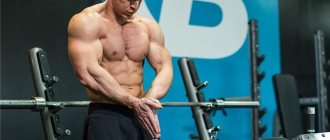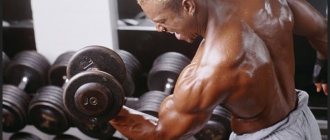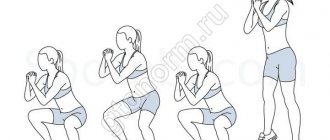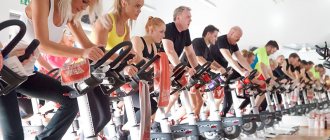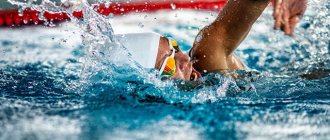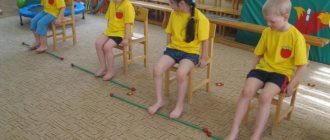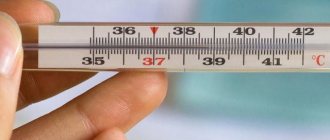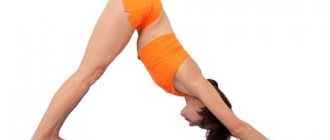Test "Physical fitness level for flexibility"
Determining the level of physical fitness is impossible without a series of tests that will show how strong and developed a person is. For example, this is the level of flexibility. You will say that this is for yogis. Nothing like this. A physically developed person must control his body.
Hips
- You need to lie down on a bench or other hard surface. The main thing is to fit completely on it.
- Move to the edge, bend your leg at the knee, pull it towards your chest.
- Dangle the other leg.
- Try to touch your heel to the floor.
Spine
- We take a straight body position and try to reach the floor with our hands. You can't bend your legs.
- It is important to understand whether there is any discomfort, whether you want to give yourself some slack and still bend your legs.
Shoulders
- You should stand up straight and extend your right arm up.
- Then you need to bend your arm and lower your palm behind your back.
- The left hand goes down. It must be placed behind the back, just like the right one.
- We touch our fingers behind our backs. This won't be easy, but you shouldn't give up.
- If the fingers do not touch each other, then let someone close to you measure this distance.
Inguinal ligaments
- We sit on the floor, bend our knees.
- We spread our knees and lower them to the floor.
- We bring our feet together, pulling them towards the groin as close as possible.
- We measure the distance between the groin and heels.
The table will help you find out what level of physical fitness you have:
| Test | Good mark | Average | Bad |
| Hip flexibility | The heel barely touched the floor | Heel below bench level | The heel did not reach the level of the bench |
| Spine | Palms were on the floor | Fingers touched the floor | Distance from fingers to floor – 10 cm or more |
| Shoulders | Fingers barely touch each other | The distance between the fingers is 5 cm | Distance – more than 5 cm |
| Inguinal ligaments | The distance from the groin to the heels is 5-10 cm | Distance - 10-20 cm | More than 20 cm |
Methods for express assessment of the level of physical condition of people[edit | edit code]
Source: “Sports Medicine”
Author:
Ed. S.P. Mironova, 2013
A number of authors have proposed formalized (in points) methods for rapid assessment of physical fitness based on the simplest clinical and physiological indicators, which have fairly high correlations with the level of an individual’s aerobic energy potential. In particular, several diagnostic systems have been created for primary (“Contrex-3”), current (“Contrex-2”) control and self-monitoring (“Contrex-1”).
Indicators for determining the level of physical condition according to the Kontrex-2 system.
- Age. Each year of life gives one point.
- Body mass. Normal body weight is estimated at 30 points. For every kilogram over the norm, 5 points are deducted.
- The normal body weight
is determined by the formula: men: 50 + (body length - 150) x 0.75 + (age - 21)/4; - women: 50 + (body length - 150) x 0.32 + (age - 21)/5.
- Arterial pressure.
Normal blood pressure is estimated at 30 points. For every 5 mm Hg. systolic or diastolic pressure above the calculated values, 6 points are subtracted from the total amount.
- Proper blood pressure
is determined by the formula: men: blood pressure syst. = 109 + 0.5 x age + 0.1 x body weight; - BP diast. = 74 + 0.1 x age + 0.15 x body weight;
- BP syst. = 102 + 0.7 x age + 0.15 x body weight;
- Pulse at rest.
For each beat less than 90, 1 point is awarded (a pulse of 70 beats gives 20 points). No points are awarded for a pulse of 90 beats or higher.
- Flexibility.
Standing on a step with legs straightened at the knees, the subject bends forward while maintaining the pose for at least 2 s. Each centimeter below the zero point (it is at the level of the feet) is scored 1 point. If the subject does not reach the zero mark, no point is awarded.
- Rapidity.
The test is performed in a standing position. The assistant takes a ruler 40 cm long and places it at a distance of 1-2 cm from the palm of the subject’s outstretched hand. The zero mark of the ruler should be at the level of the lower edge of the palm. After the “Attention” command, the assistant must lower the ruler within 5 seconds. The test subject is faced with the task of clenching his fingers into a fist and grabbing a ruler as quickly as possible. Measure the distance in centimeters from the bottom edge of the palm to the zero mark. The test is carried out 3 times, the best result is selected. For each centimeter equal to the age norm or less, 2 points are awarded (for example, a man aged 50 years has a result of 17 cm. He receives 10 points - 2 for meeting the norm and 8 points for exceeding the norm).
- Dynamic force.
Estimate the maximum height of a standing jump. For every centimeter exceeding the standard value, 2 points are awarded. Performing the test: a measuring tape (student's ruler 1 m long) is attached to the wall. Without lifting his heels, the subject raises his hand up and touches the ruler as high as possible (make a mark of the level of contact), then, moving 15-30 cm from the wall, he must jump up, pushing off with both legs, and touch the ruler again. The difference between the values of the first and second touch characterizes the height of the jump. Of the three attempts, the best one is counted.
- Speed endurance.
Calculate the maximum frequency of raising straight legs to an angle of 90? from a supine position in 20 s. For each lift equal to or exceeding the standard value, 3 points are awarded.
- Speed-strength endurance.
The maximum frequency of arm flexion is measured (in a lying position for men, in a kneeling position for women) for 30 s. For each bend equal to or exceeding the standard, 4 points are awarded.
- General endurance.
People who have started physical exercise and have been doing it for no more than 6 weeks can use the following gradation. If a person performs endurance exercise (running, swimming, skiing or skating, rowing, cycling) 5 times a week for 15 minutes, he receives 30 points, 4 times a week - 25 points, 3 times a week - 20 points, 2 times - 10 points, 1 time - 5 points, none - 0 points. The load should be performed at a pulse of at least 170 beats/min minus age in years and no more than 185 beats/min minus age in years. After 6 weeks of physical exercise, general endurance is assessed by running as far as possible for 10 minutes. For fulfilling the standard, 30 points are awarded and for every 50 m of distance exceeding this value - 15 points. For every 50 m of distance less than the age standard, 5 are subtracted from 30 points. The minimum number of points scored on this test is 0. The test is recommended for independent physical education. In a group form of training, general endurance is assessed using races over a distance of 2000 m for men and 1700 m for women. Standard time serves as control. For fulfilling the standard, 30 points are awarded and for every 10 seconds less than this value - 15 points. For every 10 seconds more than the standard, 5 are subtracted from 30 points. The minimum number of points for the test is 0.
- Pulse recovery
. For those starting classes, after 5 minutes of rest in a sitting position, the pulse is measured for 1 minute, then they are asked to do 20 squats in 40 seconds, after which, at the end of 2 minutes of recovery, their heart rate is again recorded. The resulting value is multiplied by 6. If the pulse returns to its original value, the subject receives 30 points, an excess of the pulse by 10 beats - 20 points, by 15 - 10 points, by 20 - 5 points, more than 20 beats - 10 points should be subtracted from the total amount. After 6 weeks of training, heart rate recovery is assessed 10 minutes after the end of a 10-minute run or a run over a distance of 2000 m for men and 1700 m for women by comparing the heart rate after running with the initial value. Their coincidence gives 30 points, exceeding up to 10 hits - 20 points, 15 hits - 10 points, more than 20 hits - 10 points should be subtracted from the total amount.
Assessment of the level of physical fitness using the Kontrex-2
carried out as follows.
After summing up the points obtained for all 11 indicators, the physical condition is assessed as low - less than 50 points, below average - 51-90 points, average - 91-160 points, above average - 160-250 points, high - more than 250 points.
Diagnostic system "Kontrex-3"
includes, in addition to the listed indicators of the Kontrex-2 system, an ECG assessment. With a normal ECG at rest and the absence of pathological changes during a 2-minute test with hyperventilation, the subject receives 30 points. If one of the signs of inadequacy is detected by the ECG, 10 points are subtracted from the total amount, and for each subsequent sign - 5 points.
System "Kontrex-1"
is based on risk factors for the development of coronary artery disease and consists of eight indicators: age, body weight, blood pressure and heart rate at rest, heart rate recovery after exercise, general endurance, smoking and alcohol intake. A non-smoker gets 30 points. For each cigarette smoked during the day, 1 point is deducted from the total. A person who does not drink alcohol gets 30 points. For every 100 ml of any alcoholic drink consumed at least once a week, 2 points are deducted from the accumulated amount. Occasional alcohol intake is not taken into account.
Principles for assessing the level of physical fitness using the Kontrex-1 system:
- low - <90;
- below average - 91-120;
- average - 121-170;
- above average - 171-200;
- high - >201.
In addition to those described above, there are a number of other express methods for assessing the level of physical condition of people who engage in recreational physical education. In particular, such methods include the G.L. system. Apanasenko and R.G. Naumenko (Table 1).
Power loads
Another exercise is given to test the level of physical fitness. Let's try push-ups from the floor. This exercise must be done correctly, with a straight back. As for women, they are allowed to rise from their knees.
Now let's check the results:
Men
| Grade | Age | ||
| 18-29 | 30-39 | 40+ | |
| good | 30 and more | 25 and more | 21 and older |
| Average | from 17 to 29 | 13-24 | 10-20 |
| Bad | less than 17 | less than 13 | less than 10 |
Women
| Grade | Age | ||
| 18-29 | 30-39 | 40+ | |
| good | 15 and more | 13 and more | 11 and more |
| Average | from 10 to 14 | 8-12 | 5-10 |
| Bad | less than 10 | less than 8 | less than 5 |
You can also make a plank. This test of your fitness level will show how deep your core muscles are and how developed your abs are.
- We stretch the body from the top of the head to the heels.
- We bend our arms at the elbows.
- We lock the hands together.
- You need to hold out as long as you have enough strength.
Results are considered good if a person holds the bar for more than ninety seconds, average - 60-90, but bad - less than sixty.
Ruffier index
We determine the reaction of the cardiovascular system. We measure our pulse for 15 seconds (1P). Next, we squat 30 times for 45 seconds (medium pace). Having finished the exercises, we immediately begin measuring the pulse - first in 15 seconds (2P) and, after 45 seconds, again in 15 seconds (3P).
The Ruffier index itself is determined by the following formula:
IR = (4*(1P+2P+3P)-200)-200/10.
We calculate the result:
- Index less than 0 – excellent.
- 0-3 – above average.
- 3-6 – satisfactory.
- 6-10 – below average.
- Above 10 – unsatisfactory.
In short, a result is considered excellent when the sum of heart beats is less than 50 for all three 15-second intervals.
Requirements for the level of physical fitness of military personnel
Testing the level of physical fitness is prescribed in the army for a reason. Much depends on the length of service, type of military service and rank. People associated with military service are tested for strength, endurance and speed, especially in hand-to-hand combat. Contract employees must:
- overcome 100 meters in fifteen seconds;
- run a cross-country race – 3 km in fourteen minutes;
- pull up 10 times;
- do push-ups from the floor forty-five times.
How to determine the level of physical fitness of officers? Their standards are slightly different. Officers need:
- do push-ups thirty times;
- run a three-kilometer cross-country race in fifteen minutes;
- run one hundred meters in sixteen seconds;
- do eight pull-ups.
This way you can determine the level of physical fitness of military personnel. Such stringent requirements are necessary to maintain a high level of combat effectiveness in the army.
Endurance test (squats)
Place your feet wider than your shoulders and, straightening your back, take a breath and sit down. We rise up as we exhale. Without stopping or resting, we do as many squats as we can. Next, write down the result and check it with the table:
- Less than 17 times is the lowest level.
- 28-35 times – average level.
- More than 41 times – high level.
Increased fitness levels
To determine your fitness level, you need to take into account genetics, lifestyle and overall health. It is very important to develop both flexibility and strength and endurance together, and not just one thing.
To achieve level 1 physical fitness, you should exercise 2 and a half hours every week. The minimum is two times in seven days. It is better if the duration of classes is long. Ideally, anaerobic exercises should be included; they work an entire muscle group. The main thing is not to stop studying.
In this case, walking will be effective. You can walk with a pedometer to track the distance traveled. For example, you can walk slowly for five minutes, and then increase the pace over time. You should not overexert yourself in any type of exercise. If you feel like your heart is beating too much or your muscles are hurting, then this means you have overworked. So it’s better to practice a little, but with results and without consequences.
Response of the autonomic nervous system to physical activity - orthostatic test
The test is carried out as follows:
In the morning (before exercise) or after 15 minutes (before eating), spent in a calm state and in a horizontal position, we measure the pulse in a horizontal position. We count the pulse for 1 minute. Then we get up and rest in an upright position. Again, count the pulse for 1 minute in a vertical position. The difference in the obtained values indicates the reaction of the heart to physical activity subject to a change in body position, thanks to which one can judge the fitness of the body and the “working” state of regulatory mechanisms.
Results:
- A difference of 0-10 strokes is a good result.
- A difference of 13-18 beats is an indicator of a healthy, untrained person. Rating: satisfactory.
- A difference of 18-25 strokes is unsatisfactory. Lack of physical fitness.
- Above 25 beats is a sign of overwork or some illness.
If the average difference in shocks is 8-10 for you, then the body is able to recover quickly. With an increased difference, for example, up to 20 beats, it’s worth thinking about where you are overloading the body.
